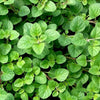Pet-Friendly Herb and Flower Garden Pack
Pet-Friendly Herb and Flower Garden Pack
Regular price
$39.95 USD
Regular price
$46.55 USD
Sale price
$39.95 USD
Unit price
per
Shipping calculated at checkout.
Couldn't load pickup availability
When our animal friends can join us outside, enjoying the benefits of gardening is enhanced even more. Pet-friendly gardening is a comprehensive strategy that puts our beloved companion animals' safety and well-being first, going beyond simply creating an aesthetically pleasing setting. As passionate pet parents, we understand how important it is to provide our animal companions with a secure space where they may explore and develop intuitive confidence. Selecting pet-safe plants is crucial for those with furry friends. This collection of seeds aims to help pet owners create a safe and attractive outside space by offering specific pet-safe flowers and herbs.
Place a single order for this item and you will get one packet of each of the items shown below at an overall discount. If you prefer, you can order them individually one by one, by clicking on each item in the list.
 Basil, Italian Large Leaf (Sweet)
Basil, Italian Large Leaf (Sweet)
Germination: 5 to 7 days A native to Europe and cultivated for centuries as a fresh and dried culinary herb. Common in America by the late 1700s. The plants grow to about eighteen inches, and provide several harvests. The leaves are used fresh to make pesto, and can be dried and used as a seasoning. A favorite in Italian dishes. Prefers well-drained soil, even moisture, and full sun.
 Plains Coreopsis
Plains Coreopsis
Synonyms for this flower include, Tickseed, Calliopsis tinctoria. It is a slender annual, reaching 12-36 inches tall, producing masses of flowers, ranging in color from deep red and bronze to bright yellow with red centers. Blooms in about 70 days. Native range from Minnesota to British Columbia, south to Louisiana and New Mexico but is a common garden escape elsewhere. Typically found in seasonally damp, disturbed sites, especially roadside ditches and low, sandy areas. Prefers full to partial sun, dry to moist, well-drained soils. In early spring, prepare your seedbed, roll or otherwise firm, scatter seeds on surface, lightly scratch in, and keep evenly moist until germination. Attracts seedeaters. Best temperature for germination is 65-75 degrees F.
 Crackerjack Mix - African Marigold
Crackerjack Mix - African Marigold
The plants are robust, reaching three to four feet in height, with solitary flowers that are two to five inches across. Crackerjack Mix, is an early, giant, carnation-type flowered mix of orange, gold and yellow. Native of Mexico and Central America, naturalized in many warm regions. Prefers full sun, dry to moderate moisture. Very popular as cut flowers and garden plants. Strongly scented. Start indoors four to six weeks before your last frost, or direct sow 1/8 inch deep, one to two weeks after last frost. Plant in rich soil for best results. Thin young plants to fifteen to eighteen inches apart.
 Nasturtium, Single Mix
Nasturtium, Single Mix
After all danger of frost has passed in the spring, sow seeds ½ to 1 inch deep, 2 to 3 inches apart, in a sunny location (partial shade in hot climates). Keep moist until germination. Thin to a final spacing of 10 inches. An annual or tender perennial, nasturtiums prefer dry, well-drained or sandy soils, are somewhat drought tolerant, but frost sensitive. They can also be started indoors in pots and transplanted after temperatures remain above 50ºF. Plants can grow 18 to 30 inches tall with round, bright green leaves on long stalks. The flowers are long-spurred in colors including red, orange, yellow, and gold. Nice as cut flowers. The young leaves, flowers, and even unripe seed pods have peppery flavor and make an interesting addition to garden salads.
 Dwarf Alyssum, Carpet of Snow
Dwarf Alyssum, Carpet of Snow
‘Dwarf Alyssum’ is a mat-forming annual plant that reaches four to six inches in height and about the same in diameter. Because of its dense, low-growing nature, it is commonly used in border plantings, rock gardens, and even in containers. The white flowers are profuse, small, ornamental, and fragrant and appear throughout the spring, summer and into fall. However, since they thrive in cooler conditions, flowering during the heat of the summer may be suspended. You will have the best success growing in pots and setting plants into your gardens. Sow seeds at a depth of about 2½ times the seed diameter. Prefers well-drained soil in a sunny to partially shady location. Do not over water and monitor the plants for damping off.
 Calendula (Pot Marigold)
Calendula (Pot Marigold)
Calendula thrives in poor soils. If you live in an area with mild winters, try sowing in mid-September for early summer blooms or plant in early spring for flowers from July onward. Early references record that it was brought from southern Europe to England in 1573. Once used as a seasoning for soups and stews (hence the name “Pot” Marigold), it is now basically enjoyed for its wonderful blooms of oranges and yellows.
 Zinnia, State Fair Mix
Zinnia, State Fair Mix
Zinnias transplant well and can be sown indoors four to six weeks before your last expected frost date. You can also wait and sow seeds directly into your garden as soon as all danger of frost has passed. Sow fifteen seeds per foot in rows two feet apart and no deeper than ½ inch. Keep soil moist until plants are up. Thin plants to 9 to 12 inches apart. Keep cultivated and water regularly but don't over water. Grow in full sun, away from trees and shade, in well-drained soil that is rich in humus. Zinnia ‘State Fair’ is a tetraploid variety that was developed decades ago when state fairs were popular settings for local competition of flower varieties, animals and food recipes. Plants have increased disease resistance and vigorous growth. The jumbo sized flowers come in shades of orange, pink, purple, red, white and yellow.
 Oregano - Common Italian
Oregano - Common Italian
Oregano is a standard kitchen herb used for Italian and Mexican dishes. Its dried leaves add a warm, spicy flavor to recipes. The plant is a perennial, has pink flowers, and spreads via under-ground runners. In early spring, sow seeds indoors, 1/8 inch deep in sterile soil. Be sure that you keep the temperature above 70ºF and provide 14 to 16 hours of light. After danger of frost has passed, and after the plants are hardened off and about three inches tall, plant outdoors in well-drained soil. Oregano prefers to be kept slightly dry and in full sun. Harvest in summer or early fall before the plants are in full bloom by cutting the stems, flower heads and all, and drying in a cool place with good air movement.
 Catnip
Catnip
Plant Height: up to 48 inches Spacing after Thinning: 2 feet Press seeds firmly into the surface of the ground and water. Very easy to grow but regulate your watering. Too much and it will die. Can be started in pots and transplanted. One whiff and your cats will be hooked. They will not be able to control themselves and will likely wallow your small plants to death. You may need to place protection around the plant in order to keep it from being mauled. The leaves are used medicinally to make a calming tea (for people). Catnip is a bushy perennial that grows two to three feet in height.
 Garden Thyme
Garden Thyme
Planting Depth: 2 times seed diameter Spacing after Thinning: 6 inches Sow seed indoors or directly in the garden in early spring. It is a long lived, woody perennial and requires little attention once established. The plant loves full sun. Plants reach eighteen inches. Can also be grown in a pot indoors and kept handy for using fresh in cooking. Used as a seasoning, it is said to help in the digestion of fatty foods. Historically, it was used medicinally for its antiseptic properties as a gargle, and in a tea as a cough remedy and digestive aid.
 Chamomile, German
Chamomile, German
Planting Depth 1/8 inch Spacing after Thinning 6 inches The seeds are tiny and do well started indoors. When the fragile plants are large enough to handle, transplant into light, dry soil that receives partial to full sun. This low growing, four to eight inch tall plant produces white flowers and makes a lovely ground cover or flowerbed border. Although it is a hardy annual, it will easily re-seed itself. The plant is very hardy. Used in teas, hair products and in potpourri. Historically, its flowers were dried and used as a medicinal tea to aid in digestion and also to strengthen the immune system.
 Coriander (Cilantro) - Slow Bolt
Coriander (Cilantro) - Slow Bolt
Planting Depth – ½ inch Plant Spacing – 5 to 8 inches Plant Height – 1 to 3 feet Coriander is very easy to grow. Sow seeds directly into the garden after danger of frost has past. It does not transplant well. The leaves are also used fresh in soups, salads and salsas. When used in this form as a fresh, green seasoning, it is called "Cilantro." After the plant has matured, the seeds are harvested to be used as the seasoning "Coriander." Coriander is used as a flavoring for meats, sausages, pickles and sauces.
 Bouquet Dill
Bouquet Dill
Germination - 7 to 10 days Planting Depth - ¼ inch Seed Spacing - 1 inch Row Spacing - 24 inches Spacing after Thinning - 8 inches Sow in average soil after all danger of frost has passed. Harvest while the flowering heads are still green. Pull plant, roots and all. Use fresh or hang upside down in a dark and dry location until completely dry. Seeds and leaves are also used dried as a culinary herb. Fine, tender parts are finely chopped and added to sauces. Also used fresh in pickling.
 Echinacea - Purple Coneflower
Echinacea - Purple Coneflower
Germination Time: 10 to 20 days Plant Height: 24 to 30 inches Planting Depth: 2X seed diameter Spacing after Thinning: 12 inches Sow the seed in early spring through summer, up until two months before first fall frost. Choose an area that receives full sun and has rich soil. If the seeds are cold conditioned moist for about 2 weeks, germination will improve. The flowers can be enjoyed cut, dried with the petals removed, and has also gained popularity for its medicinal properties.
 Lavender, English
Lavender, English
Plant Height: 24 inches Planting Depth: 2 times seed diameter Spacing after Thinning: 36 inches The seeds can be directly sown into the garden from late fall to late winter and allowed to weather through a cold period. You can also start indoors at 68F keeping them moist until germination occurs. If nothing appears, in 3 to 4 weeks, cold condition them at 24-39F for 2 to 4 weeks and then return to 68F. Enjoyed freshly cut or dried. Dried lavender flowers are used as a moth repellent. When in bloom, the sweet smelling blossoms attract butterflies and repel deer. It can be used in a moon garden to add texture and fragrance.
 Italian Parsley
Italian Parsley
Plants have deeply cut, dark green leaves with a rich, strong flavor; generally stronger in flavor than the curled types. Excellent for flavoring. Parsley has been cultivated for centuries and is used as a garnish, palate cleanser, flavoring in soups, salads, as a seasoning in other recipes, and medicinally.
 Sunflower, Giant Greystripe
Sunflower, Giant Greystripe
Planting Instructions: Sunflowers are very easy to grow and because of their size, quite spectacular for a child’s garden. Sow directly outdoors, ¾ inches deep. Thin the plants at first to 8 inches and then to two feet to avoid crowding. (We have had good luck transplanting) Water regularly and weed between the plants to eliminate competition. Harvest the seeds by cutting the flowering heads when the backs have turned yellow. Complete the drying by hanging them upside down in a warm, dry place. Scan the QR code below for more information.
Place a single order for this item and you will get one packet of each of the items shown below at an overall discount. If you prefer, you can order them individually one by one, by clicking on each item in the list.
 Basil, Italian Large Leaf (Sweet)
Basil, Italian Large Leaf (Sweet)Germination: 5 to 7 days A native to Europe and cultivated for centuries as a fresh and dried culinary herb. Common in America by the late 1700s. The plants grow to about eighteen inches, and provide several harvests. The leaves are used fresh to make pesto, and can be dried and used as a seasoning. A favorite in Italian dishes. Prefers well-drained soil, even moisture, and full sun.
 Plains Coreopsis
Plains CoreopsisSynonyms for this flower include, Tickseed, Calliopsis tinctoria. It is a slender annual, reaching 12-36 inches tall, producing masses of flowers, ranging in color from deep red and bronze to bright yellow with red centers. Blooms in about 70 days. Native range from Minnesota to British Columbia, south to Louisiana and New Mexico but is a common garden escape elsewhere. Typically found in seasonally damp, disturbed sites, especially roadside ditches and low, sandy areas. Prefers full to partial sun, dry to moist, well-drained soils. In early spring, prepare your seedbed, roll or otherwise firm, scatter seeds on surface, lightly scratch in, and keep evenly moist until germination. Attracts seedeaters. Best temperature for germination is 65-75 degrees F.
 Crackerjack Mix - African Marigold
Crackerjack Mix - African MarigoldThe plants are robust, reaching three to four feet in height, with solitary flowers that are two to five inches across. Crackerjack Mix, is an early, giant, carnation-type flowered mix of orange, gold and yellow. Native of Mexico and Central America, naturalized in many warm regions. Prefers full sun, dry to moderate moisture. Very popular as cut flowers and garden plants. Strongly scented. Start indoors four to six weeks before your last frost, or direct sow 1/8 inch deep, one to two weeks after last frost. Plant in rich soil for best results. Thin young plants to fifteen to eighteen inches apart.
 Nasturtium, Single Mix
Nasturtium, Single MixAfter all danger of frost has passed in the spring, sow seeds ½ to 1 inch deep, 2 to 3 inches apart, in a sunny location (partial shade in hot climates). Keep moist until germination. Thin to a final spacing of 10 inches. An annual or tender perennial, nasturtiums prefer dry, well-drained or sandy soils, are somewhat drought tolerant, but frost sensitive. They can also be started indoors in pots and transplanted after temperatures remain above 50ºF. Plants can grow 18 to 30 inches tall with round, bright green leaves on long stalks. The flowers are long-spurred in colors including red, orange, yellow, and gold. Nice as cut flowers. The young leaves, flowers, and even unripe seed pods have peppery flavor and make an interesting addition to garden salads.
 Dwarf Alyssum, Carpet of Snow
Dwarf Alyssum, Carpet of Snow‘Dwarf Alyssum’ is a mat-forming annual plant that reaches four to six inches in height and about the same in diameter. Because of its dense, low-growing nature, it is commonly used in border plantings, rock gardens, and even in containers. The white flowers are profuse, small, ornamental, and fragrant and appear throughout the spring, summer and into fall. However, since they thrive in cooler conditions, flowering during the heat of the summer may be suspended. You will have the best success growing in pots and setting plants into your gardens. Sow seeds at a depth of about 2½ times the seed diameter. Prefers well-drained soil in a sunny to partially shady location. Do not over water and monitor the plants for damping off.
 Calendula (Pot Marigold)
Calendula (Pot Marigold)Calendula thrives in poor soils. If you live in an area with mild winters, try sowing in mid-September for early summer blooms or plant in early spring for flowers from July onward. Early references record that it was brought from southern Europe to England in 1573. Once used as a seasoning for soups and stews (hence the name “Pot” Marigold), it is now basically enjoyed for its wonderful blooms of oranges and yellows.
 Zinnia, State Fair Mix
Zinnia, State Fair MixZinnias transplant well and can be sown indoors four to six weeks before your last expected frost date. You can also wait and sow seeds directly into your garden as soon as all danger of frost has passed. Sow fifteen seeds per foot in rows two feet apart and no deeper than ½ inch. Keep soil moist until plants are up. Thin plants to 9 to 12 inches apart. Keep cultivated and water regularly but don't over water. Grow in full sun, away from trees and shade, in well-drained soil that is rich in humus. Zinnia ‘State Fair’ is a tetraploid variety that was developed decades ago when state fairs were popular settings for local competition of flower varieties, animals and food recipes. Plants have increased disease resistance and vigorous growth. The jumbo sized flowers come in shades of orange, pink, purple, red, white and yellow.
 Oregano - Common Italian
Oregano - Common ItalianOregano is a standard kitchen herb used for Italian and Mexican dishes. Its dried leaves add a warm, spicy flavor to recipes. The plant is a perennial, has pink flowers, and spreads via under-ground runners. In early spring, sow seeds indoors, 1/8 inch deep in sterile soil. Be sure that you keep the temperature above 70ºF and provide 14 to 16 hours of light. After danger of frost has passed, and after the plants are hardened off and about three inches tall, plant outdoors in well-drained soil. Oregano prefers to be kept slightly dry and in full sun. Harvest in summer or early fall before the plants are in full bloom by cutting the stems, flower heads and all, and drying in a cool place with good air movement.
 Catnip
CatnipPlant Height: up to 48 inches Spacing after Thinning: 2 feet Press seeds firmly into the surface of the ground and water. Very easy to grow but regulate your watering. Too much and it will die. Can be started in pots and transplanted. One whiff and your cats will be hooked. They will not be able to control themselves and will likely wallow your small plants to death. You may need to place protection around the plant in order to keep it from being mauled. The leaves are used medicinally to make a calming tea (for people). Catnip is a bushy perennial that grows two to three feet in height.
 Garden Thyme
Garden ThymePlanting Depth: 2 times seed diameter Spacing after Thinning: 6 inches Sow seed indoors or directly in the garden in early spring. It is a long lived, woody perennial and requires little attention once established. The plant loves full sun. Plants reach eighteen inches. Can also be grown in a pot indoors and kept handy for using fresh in cooking. Used as a seasoning, it is said to help in the digestion of fatty foods. Historically, it was used medicinally for its antiseptic properties as a gargle, and in a tea as a cough remedy and digestive aid.
 Chamomile, German
Chamomile, GermanPlanting Depth 1/8 inch Spacing after Thinning 6 inches The seeds are tiny and do well started indoors. When the fragile plants are large enough to handle, transplant into light, dry soil that receives partial to full sun. This low growing, four to eight inch tall plant produces white flowers and makes a lovely ground cover or flowerbed border. Although it is a hardy annual, it will easily re-seed itself. The plant is very hardy. Used in teas, hair products and in potpourri. Historically, its flowers were dried and used as a medicinal tea to aid in digestion and also to strengthen the immune system.
 Coriander (Cilantro) - Slow Bolt
Coriander (Cilantro) - Slow BoltPlanting Depth – ½ inch Plant Spacing – 5 to 8 inches Plant Height – 1 to 3 feet Coriander is very easy to grow. Sow seeds directly into the garden after danger of frost has past. It does not transplant well. The leaves are also used fresh in soups, salads and salsas. When used in this form as a fresh, green seasoning, it is called "Cilantro." After the plant has matured, the seeds are harvested to be used as the seasoning "Coriander." Coriander is used as a flavoring for meats, sausages, pickles and sauces.
 Bouquet Dill
Bouquet DillGermination - 7 to 10 days Planting Depth - ¼ inch Seed Spacing - 1 inch Row Spacing - 24 inches Spacing after Thinning - 8 inches Sow in average soil after all danger of frost has passed. Harvest while the flowering heads are still green. Pull plant, roots and all. Use fresh or hang upside down in a dark and dry location until completely dry. Seeds and leaves are also used dried as a culinary herb. Fine, tender parts are finely chopped and added to sauces. Also used fresh in pickling.
 Echinacea - Purple Coneflower
Echinacea - Purple ConeflowerGermination Time: 10 to 20 days Plant Height: 24 to 30 inches Planting Depth: 2X seed diameter Spacing after Thinning: 12 inches Sow the seed in early spring through summer, up until two months before first fall frost. Choose an area that receives full sun and has rich soil. If the seeds are cold conditioned moist for about 2 weeks, germination will improve. The flowers can be enjoyed cut, dried with the petals removed, and has also gained popularity for its medicinal properties.
 Lavender, English
Lavender, EnglishPlant Height: 24 inches Planting Depth: 2 times seed diameter Spacing after Thinning: 36 inches The seeds can be directly sown into the garden from late fall to late winter and allowed to weather through a cold period. You can also start indoors at 68F keeping them moist until germination occurs. If nothing appears, in 3 to 4 weeks, cold condition them at 24-39F for 2 to 4 weeks and then return to 68F. Enjoyed freshly cut or dried. Dried lavender flowers are used as a moth repellent. When in bloom, the sweet smelling blossoms attract butterflies and repel deer. It can be used in a moon garden to add texture and fragrance.
 Italian Parsley
Italian ParsleyPlants have deeply cut, dark green leaves with a rich, strong flavor; generally stronger in flavor than the curled types. Excellent for flavoring. Parsley has been cultivated for centuries and is used as a garnish, palate cleanser, flavoring in soups, salads, as a seasoning in other recipes, and medicinally.
 Sunflower, Giant Greystripe
Sunflower, Giant GreystripePlanting Instructions: Sunflowers are very easy to grow and because of their size, quite spectacular for a child’s garden. Sow directly outdoors, ¾ inches deep. Thin the plants at first to 8 inches and then to two feet to avoid crowding. (We have had good luck transplanting) Water regularly and weed between the plants to eliminate competition. Harvest the seeds by cutting the flowering heads when the backs have turned yellow. Complete the drying by hanging them upside down in a warm, dry place. Scan the QR code below for more information.

Explore our vegetable collections:
[ Artichokes | Asparagus | Beans | Beets | Broccoli | Sorghums | Brussels Sprouts | Cabbage | Cantaloupe | Carrots | Cauliflower | Celery | Collard Greens | Corn | Cucumber | Eggplant | Endives | Gourds | Kale | Kohlrabi | Leeks | Lettuce | Mesclun Mix | Mustard Greens | Okra | Onions | Parsley | Edible Pod Peas | Garden Peas | South Peas | Hot Peppers | Mild Peppers | Pumpkins | Radishes | Rapini | Rhubarb | Salad Greens | Salsify | Summer Squash | Winter Squash | Swiss Chard | Tomatillo | Tomatoes | Dwarf Tomato Project | Turnips | Watermelons ]

